DavidJHupp
About
- Username
- DavidJHupp
- Joined
- Visits
- 2
- Last Active
- Roles
- member
- Points
- 17
- Badges
- 0
- Posts
- 4
Reactions
-
How Apple addressed the 'beautygate' effect in iOS 12.1
-
McDonald's in Chicago is the latest Apple Store copycat - but not the first by far
-
McDonald's in Chicago is the latest Apple Store copycat - but not the first by far
nytesky said:1. This is a modernist aesthetic that exposes structural elements, something referred to as structural honesty. Apple does not employee this type of aesthetic.2. All glass systems were around decades before Apple started using them. This particular McDonald's uses a structural mullion system for the glass, something Apple has not done for a long time since they first went to a structural glass system in New York City at the Cube.3. No one would mistake this interior for Apple.It is quite a stretch to say that this McDonald's is copying their aesthetic of Apple Stores.
flippysch said:ITT in Chicago has another ripoff of the minimalist architecture style.
pharding said:The idea that wood and glass architecture was a unique creation of Apple is absurd. The Apple aesthetic while extremely well done and beautiful, is not unique to Apple. Others did it decades prior to Apple.
Paul Harding FAIA
Harding Partners Architects
ChicagoStephen, no offense, this article pretty insulting to the architectural heritage of Chicago, and it’s pretty sexist as well.The new Michigan Avenue Apple Store was designed by Sir Norman Foster (definitely not a local), and while it’s a very good design, Foster has explicitly stated that the design of the roof was inspired by the architecture of Frank Lloyd Wright, specifically the deep, shallow roof overhang of Wright’s Robie House in Hyde Park, Chicago:
https://www.archdaily.com/777769/chicagos-new-apple-store-is-inspired-by-frank-lloyd-wrights-prairie-homes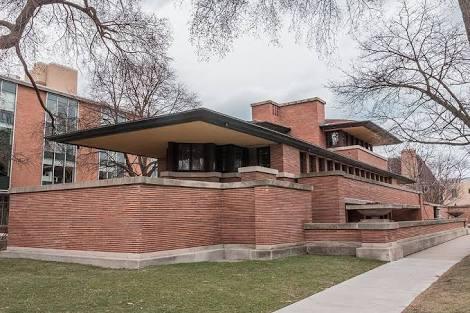 If we’re going to talk about “copycat designs”, perhaps an explicitly derivative design isn’t the best starting point?Second, Apple and Foster hardly have a monopoly on glass boxes. In fact, Mies van der Rohe, arguably the father of glass boxes, spent the balance of his career in Chicago after fleeing Nazi Germany. Some of Mies’s most iconic designs are glass boxes around Chicago:The Farnsworth House is arguably the purest example of glass box architecture in the entire world, and is located outside Chicago:
If we’re going to talk about “copycat designs”, perhaps an explicitly derivative design isn’t the best starting point?Second, Apple and Foster hardly have a monopoly on glass boxes. In fact, Mies van der Rohe, arguably the father of glass boxes, spent the balance of his career in Chicago after fleeing Nazi Germany. Some of Mies’s most iconic designs are glass boxes around Chicago:The Farnsworth House is arguably the purest example of glass box architecture in the entire world, and is located outside Chicago: Unlike Phillip Johnson’s Glass House, or either the Fifth Avenue or Michigan Avenue Apple Stores, which are really entrances to subterranean buildings, the Farnsworth House is a pure glass box, suspended above the ground, with nothing above or below.Another iconic Mies glass box is S. R. Crown Hall at the Illinois Institute of Chicago, built to house IIT’s school of architecture while Mies was the director of the school:
Unlike Phillip Johnson’s Glass House, or either the Fifth Avenue or Michigan Avenue Apple Stores, which are really entrances to subterranean buildings, the Farnsworth House is a pure glass box, suspended above the ground, with nothing above or below.Another iconic Mies glass box is S. R. Crown Hall at the Illinois Institute of Chicago, built to house IIT’s school of architecture while Mies was the director of the school:
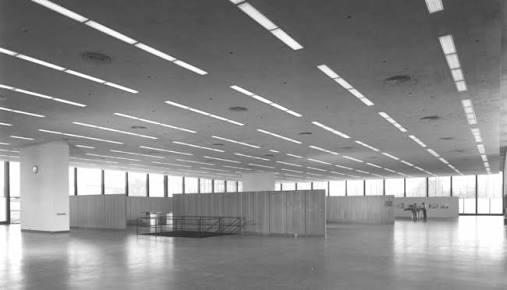
 Unlike the Michigan Avenue Apple Store, Crown Hall has no interior columns or structural walls. The roof of Crown Hall is supported entirely by girders held up by slender, almost invisible steel columns at the perimeter. Sir Norman Foster’s Michigan Avenue Apple Store “cheats” by using aluminum-clad interior columns, and the result is not nearly as magical as either the Farnsworth House or Crown Hall.Both the Farnsworth House and Crown Hall are among the most iconic buildings of the 20th century. Both are listed on the US National Register of Historic Places, and both are US National Historic Landmarks. It’s pretty insulting when people from the coasts think that Chicago has no architecture, when Chicago was home to arguably the most iconic modern architect of the 20th century.Anyway, if you’re going to talk about “copycat architecture”, maybe you should find a different starting point than a building explicitly influenced by Frank Lloyd Wright, a glass box in the city that *invented* glass boxes.Further, if you’re choosing architects to insult, you should choose someone other than Carol Ross Barney, the architect who designed the new flagship McDonald’s. Ross Barney is one of the most esteemed living architects in Chicago, and in 2017 she was awarded the AIA Chicago Lifetime Achievement Award. This January, Metropolis Magazine pronounced that “Carol Ross Barney is Chicago’s New Daniel Burnham”:Here’s Carol Ross Barney standing on the Chicago Riverwalk (that she designed), about four blocks from the new Apple Store:
Unlike the Michigan Avenue Apple Store, Crown Hall has no interior columns or structural walls. The roof of Crown Hall is supported entirely by girders held up by slender, almost invisible steel columns at the perimeter. Sir Norman Foster’s Michigan Avenue Apple Store “cheats” by using aluminum-clad interior columns, and the result is not nearly as magical as either the Farnsworth House or Crown Hall.Both the Farnsworth House and Crown Hall are among the most iconic buildings of the 20th century. Both are listed on the US National Register of Historic Places, and both are US National Historic Landmarks. It’s pretty insulting when people from the coasts think that Chicago has no architecture, when Chicago was home to arguably the most iconic modern architect of the 20th century.Anyway, if you’re going to talk about “copycat architecture”, maybe you should find a different starting point than a building explicitly influenced by Frank Lloyd Wright, a glass box in the city that *invented* glass boxes.Further, if you’re choosing architects to insult, you should choose someone other than Carol Ross Barney, the architect who designed the new flagship McDonald’s. Ross Barney is one of the most esteemed living architects in Chicago, and in 2017 she was awarded the AIA Chicago Lifetime Achievement Award. This January, Metropolis Magazine pronounced that “Carol Ross Barney is Chicago’s New Daniel Burnham”:Here’s Carol Ross Barney standing on the Chicago Riverwalk (that she designed), about four blocks from the new Apple Store: The Michigan Avenue Apple Store is lauded for its location on the Chicago Riverwalk... which was designed by Carol Ross Barney, who spent a decade pushing the project through federal bureaucracy. Without Carol Ross Barney, there most likely wouldn’t be an Apple Store on the Riverwalk in the first place.Furthermore, while I doubt that you thought much about the identity of the architect of the flagship McDonald’s, it certainly leaves a sour taste in the mouth that you give Foster, a man, a free pass for an explicitly derivative design, but you accuse Ross Barney, a woman, of “copying” Foster’s derivative design. That sour taste is sexism of course.Needless to say, Ross Barney didn’t “copy” Foster any more than Foster “copied” Frank Lloyd Wright or Mies van der Rohe (or, for that matter, Phillip Johnson). And from an architecture history standpoint, there are much more obvious antecedents for the new flagship McDonald’s than the new Michigan Avenue Apple Store. For example, I would argue that the floating roof of the new McDonald’s more strongly resembles the floating roof of Renzo Piano’s Modern Wing at the Art Institute of Chicago than it resembles anything Apple or Foster have designed:For comparison:
The Michigan Avenue Apple Store is lauded for its location on the Chicago Riverwalk... which was designed by Carol Ross Barney, who spent a decade pushing the project through federal bureaucracy. Without Carol Ross Barney, there most likely wouldn’t be an Apple Store on the Riverwalk in the first place.Furthermore, while I doubt that you thought much about the identity of the architect of the flagship McDonald’s, it certainly leaves a sour taste in the mouth that you give Foster, a man, a free pass for an explicitly derivative design, but you accuse Ross Barney, a woman, of “copying” Foster’s derivative design. That sour taste is sexism of course.Needless to say, Ross Barney didn’t “copy” Foster any more than Foster “copied” Frank Lloyd Wright or Mies van der Rohe (or, for that matter, Phillip Johnson). And from an architecture history standpoint, there are much more obvious antecedents for the new flagship McDonald’s than the new Michigan Avenue Apple Store. For example, I would argue that the floating roof of the new McDonald’s more strongly resembles the floating roof of Renzo Piano’s Modern Wing at the Art Institute of Chicago than it resembles anything Apple or Foster have designed:For comparison:
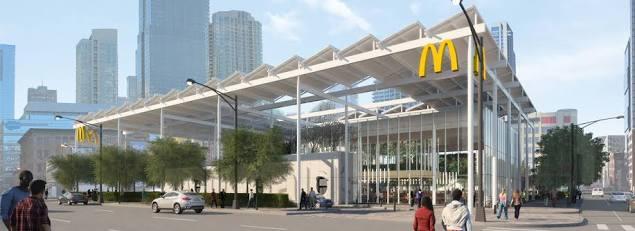
 I’m also going to point out that, ignoring the roof and the glass box, the Apple Store is a combination of stone steps and theater seats leading down to the Riverwalk:
I’m also going to point out that, ignoring the roof and the glass box, the Apple Store is a combination of stone steps and theater seats leading down to the Riverwalk:


 And the concept is eerily similar to the “River Theater” just a few blocks the river, which opened on the Riverwalk two years earlier, and was designed by none other than Carol Ross Barney, the architect of the new McDonald's!
And the concept is eerily similar to the “River Theater” just a few blocks the river, which opened on the Riverwalk two years earlier, and was designed by none other than Carol Ross Barney, the architect of the new McDonald's!
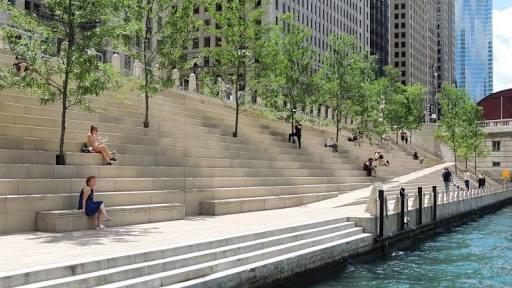
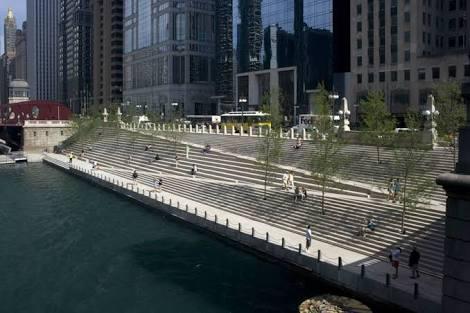

 So maybe you’re right, maybe this is a case of “copycat architecture”... only you got it backwards, because it looks a whole lot more like Sir Norman Foster copied Carol Ross Barney, and not the other way around!P.S. the Riverwalk also gets bonus points for actually being a public space, instead of being a commercial space (although there are concessionaires). Unlike nearby Millennium Park, the Riverwalk has no corporate sponsorships or naming rights!Despite the roof, glass box, and steps all being derivative, the new Apple Store is generally well designed, and the most interesting thing about the design is actually the rounded glass corners of the glass and of the roof. So, while Apple did in fact invent the rounded rectangle (https://www.folklore.org/StoryView.py?story=Round_Rects_Are_Everywhere.txt), neither Apple nor Sir Norman Foster invented glass boxes, floating roofs, nor theater seat steps down to the Chicago River.
So maybe you’re right, maybe this is a case of “copycat architecture”... only you got it backwards, because it looks a whole lot more like Sir Norman Foster copied Carol Ross Barney, and not the other way around!P.S. the Riverwalk also gets bonus points for actually being a public space, instead of being a commercial space (although there are concessionaires). Unlike nearby Millennium Park, the Riverwalk has no corporate sponsorships or naming rights!Despite the roof, glass box, and steps all being derivative, the new Apple Store is generally well designed, and the most interesting thing about the design is actually the rounded glass corners of the glass and of the roof. So, while Apple did in fact invent the rounded rectangle (https://www.folklore.org/StoryView.py?story=Round_Rects_Are_Everywhere.txt), neither Apple nor Sir Norman Foster invented glass boxes, floating roofs, nor theater seat steps down to the Chicago River.
Please research these things better in the future before writing insulting articles like these again. I would even argue that this insult warrants a retraction because of the sexism inherent in accusing a female architect of “copying” a male architect’s explicitly derivative design.
David Hupp


